Jennifer Bohnhoff's Blog, page 13
July 5, 2023
The Drummer Boy of Valverde
A Gothic Ghost story by Jennifer Bohnhoff,
based on the Characters in
her Historical Novel, Where Duty Calls They lined up now, in three long rows behind the low sand hill. The front line, all 200 of them, prone against the hill while the back two lines, the second wave of 250 and the third wave of 300, squatted on their heels. Behind them, sergeants walked up and down, shouting at the men to make sure their guns had a priming cap in place, to shoot low, and not until they were within effective range.
They lined up now, in three long rows behind the low sand hill. The front line, all 200 of them, prone against the hill while the back two lines, the second wave of 250 and the third wave of 300, squatted on their heels. Behind them, sergeants walked up and down, shouting at the men to make sure their guns had a priming cap in place, to shoot low, and not until they were within effective range.
The whites of their eyes, Jemmy thought, then wondered where he’d heard that before.
Don’t shoot until you see the whites of their eyes.
He glanced right, at Jaspar Jones, whose hands trembled and whose eyes looked as round as a rabbit’s. Plenty of white showing, all the way around. Jones’d make a fine target if the Abolitionists were looking for the whites of his eyes. Jemmy looked past him at the line of men. Some twitched in anticipation of the fight to come. Some used the backs of their hands to wipe tears from their faces. Some prayed, their hands clutched together as their lips moved with the earnest intensity that only the doomed can know. Some men lay so still that he wondered if they’d gone to sleep.
Behind him, Colonel Green called for the men’s attention. The line quieted. Everyone trusted “Daddy” Green to do right by them.
“Boys,” he called, “I want Colonel Canby’s guns! When I yell, raise the Rebel yell and follow me!”
All along the line, men affirmed the Colonel, some with cheers and others with quiet “yes, sirs.” Jemmy felt his resolve harden into a knot in his throat. Afraid his voice would come out in a squeak, he nodded his assent.
He looked left and noticed Wee Willie squatting close by, his drumsticks clutched in his fists, his jaw set with a gritty determination that made the boy look old beyond his years. Willie’s pale skin looked even paler than usual, his black eyes sunken into his face. He was a curious one, that Willie: so small that Jemmy couldn’t look at him without wondering how his Mama could have let him run off to war. Some said he was an orphan, but that was just a rumor. Willie never spoke. He hung around the edges of the camp, eating what others offered him, sleeping on the floor of the Colonel’s tent like a pet pup.
Just beyond Willie, John Norvell and Frederick Wade hunkered shoulder to shoulder.
“Fred, we are whipped, and I will never see my mother again!” John said in between wracking sobs.
Jemmy closed his eyes, trying to wipe the image of Norvell’s tears from his mind. He raised one shoulder and then the other, lessening the tension in his back. The shoot low part bothered him. Sure, it was just fine if he did it. He was in the first line of men and there’d be nothing in front of him except blue coats. It didn’t matter if he hit them in the head or the kneecap. Shot was shot, and a Yank with a ball in him wouldn’t be trying to return the favor. But Jemmy wasn’t so sure he wanted the second or third waves of men, the men who came behind him, to be shooting low. He didn’t cotton to taking a ball in the back. Not from one of his own. Not when it might be mistaken as a mark that Jemmy was running from the Federal line instead of toward it. He didn’t want to be mistaken for a coward.
The ghostly sun, a pale disk behind thin, gray clouds, hung high overhead, a little past the apex. Snow had started again, tiny dry pellets brought in almost horizontal that it bit his cheeks and made his eyes water. Why did the wind have to come from the west today? Why couldn’t it be at his back, pushing him on towards victory? It seemed like God himself was against him.
He stretched his neck, thrusting his chin forward so he could look over the top of the hill without exposing the crown of his head. There, not 800 yards from him, Federal cannons pointed directly at him, their open muzzles looking like astonished mouths. Soon, he knew, they’d be belching fire at him. Fire, and deadly chunks of metal.
Jemmy shook his head hard. He had to stop talking scary to himself or he was going to end up like Norvell or Jones. Shaking his head didn’t dislodge the images that swirled around in his head like ghost stories. He knew he needed to hear the sound of his own voice, to talk himself calm like he did with his mules.
“You ain’t got nothing to be scairt of,” he told himself in as convincing a manner as he could muster. “The men behind you is there to support you, not shoot you in the back. And the snow and wind? It done mask our sound. It’ll confuse the Federals into thinking there’re less of us than there are. An’ grapeshot and canister’s aimed at the generals and such. Them cannons ain’t interested in a little guy like me.”
Jemmy gave his head a firm nod, but ghastly, terrifying images kept pushing his convictions from him. He frowned. If he couldn’t be brave from himself, perhaps he could be brave for someone else. He grabbed We Willie’s shoulder, pulling the drummer boy into a side embrace.
“This here’s your first fight, son, but you got nothing to be scairt of,” Jemmy said, more to himself than to Willie. “God’s on our side, sure as shoot’n. He ain’t going to let us down. When we let go our rebel yell, them Abs’ll skedaddle back to their fort with their tails between their legs and we’ll take possession of those fine guns. So don’t you worry none. It’s on to San Francisco for us.”
Jemmy pounded the drummer boy into his side with a series of encouraging whacks. He didn’t know if he had said anything to calm Wee Willie, but he was beginning to feel better already.
Willie pulled away from Jemmy. He scrambled back to his feet. He held up his fists, the sticks ready to beat the advance, sending men over the hill and into the cannon’s line of fire.
“You are mistaken, Private.” Willie’s little voice lilted as high and light as birdsong. The sound of it surprised Jemmy. He was sure this was the first time he’d ever heard the drummer boy speak. “This is not my first fight. I have been leading men into battle since time immemorial. It was I who beat the advance at Waterloo. I who beat at Yorktown. At Agincourt. And Thermopylae. But you are right in one respect: I have nothing to be afraid of.”
The boy pulled back his lips in a grin that was more grimace, and the two rows of teeth gave his pale face a skull-like appearance. Jemmy swore that his eyes gleamed a bright and burning red. Jemmy’s mouth dropped open in astonishment, but before he could draw breath, Colonel Green’s voice filled his ears.
“Up, boys, and at ‘em!”
Wee Willie beat the advance and two hundred men bellowed the rebel yell and clambered over the hill. Where Duty Calls is the first book in a trilogy of historical novels set in New Mexico during the time of the American Civil War. It is written for middle grade readers and adults who want to learn about the war in an immersive way. Published by Kinkajou Press, a division of Artemesia Publishing, a free, 100 page teacher's guide is available on the publisher's website. Teachers, ask about special discounts for class sets. The author, Jennifer Bohnhoff, is available for in person and online meetings. presentations, and discussions.
based on the Characters in
her Historical Novel, Where Duty Calls
 They lined up now, in three long rows behind the low sand hill. The front line, all 200 of them, prone against the hill while the back two lines, the second wave of 250 and the third wave of 300, squatted on their heels. Behind them, sergeants walked up and down, shouting at the men to make sure their guns had a priming cap in place, to shoot low, and not until they were within effective range.
They lined up now, in three long rows behind the low sand hill. The front line, all 200 of them, prone against the hill while the back two lines, the second wave of 250 and the third wave of 300, squatted on their heels. Behind them, sergeants walked up and down, shouting at the men to make sure their guns had a priming cap in place, to shoot low, and not until they were within effective range. The whites of their eyes, Jemmy thought, then wondered where he’d heard that before.
Don’t shoot until you see the whites of their eyes.
He glanced right, at Jaspar Jones, whose hands trembled and whose eyes looked as round as a rabbit’s. Plenty of white showing, all the way around. Jones’d make a fine target if the Abolitionists were looking for the whites of his eyes. Jemmy looked past him at the line of men. Some twitched in anticipation of the fight to come. Some used the backs of their hands to wipe tears from their faces. Some prayed, their hands clutched together as their lips moved with the earnest intensity that only the doomed can know. Some men lay so still that he wondered if they’d gone to sleep.
Behind him, Colonel Green called for the men’s attention. The line quieted. Everyone trusted “Daddy” Green to do right by them.
“Boys,” he called, “I want Colonel Canby’s guns! When I yell, raise the Rebel yell and follow me!”
All along the line, men affirmed the Colonel, some with cheers and others with quiet “yes, sirs.” Jemmy felt his resolve harden into a knot in his throat. Afraid his voice would come out in a squeak, he nodded his assent.
He looked left and noticed Wee Willie squatting close by, his drumsticks clutched in his fists, his jaw set with a gritty determination that made the boy look old beyond his years. Willie’s pale skin looked even paler than usual, his black eyes sunken into his face. He was a curious one, that Willie: so small that Jemmy couldn’t look at him without wondering how his Mama could have let him run off to war. Some said he was an orphan, but that was just a rumor. Willie never spoke. He hung around the edges of the camp, eating what others offered him, sleeping on the floor of the Colonel’s tent like a pet pup.
Just beyond Willie, John Norvell and Frederick Wade hunkered shoulder to shoulder.
“Fred, we are whipped, and I will never see my mother again!” John said in between wracking sobs.
Jemmy closed his eyes, trying to wipe the image of Norvell’s tears from his mind. He raised one shoulder and then the other, lessening the tension in his back. The shoot low part bothered him. Sure, it was just fine if he did it. He was in the first line of men and there’d be nothing in front of him except blue coats. It didn’t matter if he hit them in the head or the kneecap. Shot was shot, and a Yank with a ball in him wouldn’t be trying to return the favor. But Jemmy wasn’t so sure he wanted the second or third waves of men, the men who came behind him, to be shooting low. He didn’t cotton to taking a ball in the back. Not from one of his own. Not when it might be mistaken as a mark that Jemmy was running from the Federal line instead of toward it. He didn’t want to be mistaken for a coward.
The ghostly sun, a pale disk behind thin, gray clouds, hung high overhead, a little past the apex. Snow had started again, tiny dry pellets brought in almost horizontal that it bit his cheeks and made his eyes water. Why did the wind have to come from the west today? Why couldn’t it be at his back, pushing him on towards victory? It seemed like God himself was against him.
He stretched his neck, thrusting his chin forward so he could look over the top of the hill without exposing the crown of his head. There, not 800 yards from him, Federal cannons pointed directly at him, their open muzzles looking like astonished mouths. Soon, he knew, they’d be belching fire at him. Fire, and deadly chunks of metal.
Jemmy shook his head hard. He had to stop talking scary to himself or he was going to end up like Norvell or Jones. Shaking his head didn’t dislodge the images that swirled around in his head like ghost stories. He knew he needed to hear the sound of his own voice, to talk himself calm like he did with his mules.
“You ain’t got nothing to be scairt of,” he told himself in as convincing a manner as he could muster. “The men behind you is there to support you, not shoot you in the back. And the snow and wind? It done mask our sound. It’ll confuse the Federals into thinking there’re less of us than there are. An’ grapeshot and canister’s aimed at the generals and such. Them cannons ain’t interested in a little guy like me.”
Jemmy gave his head a firm nod, but ghastly, terrifying images kept pushing his convictions from him. He frowned. If he couldn’t be brave from himself, perhaps he could be brave for someone else. He grabbed We Willie’s shoulder, pulling the drummer boy into a side embrace.
“This here’s your first fight, son, but you got nothing to be scairt of,” Jemmy said, more to himself than to Willie. “God’s on our side, sure as shoot’n. He ain’t going to let us down. When we let go our rebel yell, them Abs’ll skedaddle back to their fort with their tails between their legs and we’ll take possession of those fine guns. So don’t you worry none. It’s on to San Francisco for us.”
Jemmy pounded the drummer boy into his side with a series of encouraging whacks. He didn’t know if he had said anything to calm Wee Willie, but he was beginning to feel better already.
Willie pulled away from Jemmy. He scrambled back to his feet. He held up his fists, the sticks ready to beat the advance, sending men over the hill and into the cannon’s line of fire.
“You are mistaken, Private.” Willie’s little voice lilted as high and light as birdsong. The sound of it surprised Jemmy. He was sure this was the first time he’d ever heard the drummer boy speak. “This is not my first fight. I have been leading men into battle since time immemorial. It was I who beat the advance at Waterloo. I who beat at Yorktown. At Agincourt. And Thermopylae. But you are right in one respect: I have nothing to be afraid of.”
The boy pulled back his lips in a grin that was more grimace, and the two rows of teeth gave his pale face a skull-like appearance. Jemmy swore that his eyes gleamed a bright and burning red. Jemmy’s mouth dropped open in astonishment, but before he could draw breath, Colonel Green’s voice filled his ears.
“Up, boys, and at ‘em!”
Wee Willie beat the advance and two hundred men bellowed the rebel yell and clambered over the hill. Where Duty Calls is the first book in a trilogy of historical novels set in New Mexico during the time of the American Civil War. It is written for middle grade readers and adults who want to learn about the war in an immersive way. Published by Kinkajou Press, a division of Artemesia Publishing, a free, 100 page teacher's guide is available on the publisher's website. Teachers, ask about special discounts for class sets. The author, Jennifer Bohnhoff, is available for in person and online meetings. presentations, and discussions.
Published on July 05, 2023 03:14
June 28, 2023
Buried in a Bacon Box
 Towards the end of The Bent Reed, my middle grade novel set in Gettysburg during the Civil War, the main character finds her father working in his carpentry shop. He is sawing planks to make coffins, using the wood from Rose's Wood Lot, a small field that stood near what became known as Devil's Den. The woodlot had been the scene of fierce fighting. Most of the trees had lost all their leaves. Many had never recovered. Pa laughs sadly and says that it is fitting for men to be buried in wood that had died the same day as they. As Pa works, others are exhuming bodies hastily buried in fields and roadsides throughout the area. A month after this scene, President Lincoln will come to dedicate a new cemetery. He gives the Gettysburg Address at that dedication.
Towards the end of The Bent Reed, my middle grade novel set in Gettysburg during the Civil War, the main character finds her father working in his carpentry shop. He is sawing planks to make coffins, using the wood from Rose's Wood Lot, a small field that stood near what became known as Devil's Den. The woodlot had been the scene of fierce fighting. Most of the trees had lost all their leaves. Many had never recovered. Pa laughs sadly and says that it is fitting for men to be buried in wood that had died the same day as they. As Pa works, others are exhuming bodies hastily buried in fields and roadsides throughout the area. A month after this scene, President Lincoln will come to dedicate a new cemetery. He gives the Gettysburg Address at that dedication.
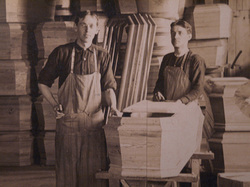 Not every Union soldier got the benefit of being buried in a coffin. In I Married A Soldier, a memoir of Army life in the Southwest during the 1850s-1870s, Lydia Spencer Lane explains that wood was so scarce that it was customary to forgo burying coffins. She was told in Santa Fe that bodies were carried to the church in one, but removed and rolled in old blankets before being consigned to the tomb. Thus, coffins could be used and reused indefinitely.
Not every Union soldier got the benefit of being buried in a coffin. In I Married A Soldier, a memoir of Army life in the Southwest during the 1850s-1870s, Lydia Spencer Lane explains that wood was so scarce that it was customary to forgo burying coffins. She was told in Santa Fe that bodies were carried to the church in one, but removed and rolled in old blankets before being consigned to the tomb. Thus, coffins could be used and reused indefinitely.This was not acceptable to people who had been raised in the East, who did everything within their power to create coffins for their dead. Ms. Lane explains that, when there was not enough lumber at hand to make a coffin, old packing boxes and commissary boxes were brought into requisition. She recalled one officer who died at a post in Texas and was carried to his final resting place in a very rough coffin which had marked, in great black letters along the side, "200 lbs. bacon."
 In Where Duty Calls, the first book in Rebels Along the Rio Grande, my trilogy set in New Mexico during the Civil War, a Confederate soldier who dies on pneumonia while on the campaign trail is buried in a coffin created from packing crates. William Kemp, the dead soldier, is an actual person, and the record of his death is part of the official records of Sibley's campaign to capture the west and its gold.
In Where Duty Calls, the first book in Rebels Along the Rio Grande, my trilogy set in New Mexico during the Civil War, a Confederate soldier who dies on pneumonia while on the campaign trail is buried in a coffin created from packing crates. William Kemp, the dead soldier, is an actual person, and the record of his death is part of the official records of Sibley's campaign to capture the west and its gold.
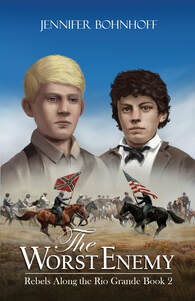 Jennifer Bohnhoff is the author of historical fiction novels for middle school readers through adults. Book two of Rebels Along the Rio Grande will be published by Artemesia Publishing in August, 2023 and is available for preorder on Bookshop.org.
Jennifer Bohnhoff is the author of historical fiction novels for middle school readers through adults. Book two of Rebels Along the Rio Grande will be published by Artemesia Publishing in August, 2023 and is available for preorder on Bookshop.org.
Published on June 28, 2023 03:15
June 5, 2023
Cherry Clafouti to Commemorate D-Day
Clafouti is a French dessert that looks beautiful and is simple to make. It might be just the thing to make in early June, when cherries are ripe and we think back to D-Day and the sacrifices our Allied troops made when they stormed the beaches of Normandy to wrest control from German troops.  Clafouti
Clafouti
1 1/2 sweet cherries, pitted
1 cup milk
1/2 cup whipping cream
1/2 cup flour
4 eggs
1/2 cup sugar
1/8 tsp salt
1 tsp almond extract or kirsch
confectioner's sugar for dusting
Preheat oven to 350°
Butter a 1 ½ quart baking dish with low sides.
Arrange the cherries in a single layer in the dish.
Combine the milk and cream in a saucepan and heat but do not boil. Remove from heat and use a whisk to add the flour a little at a time until well blended.
Wisk together the eggs, sugar and salt in a small bowl. Add the kirsch or almond extract and the heated milk mixture and pour over the cherries.
Bake 45-55 minutes, until browned and puffed, yet still soft I the center. A knife stuck into the center should come out clean.
Transfer to a rack and cool slightly before dusting with confectioner’s sugar. Serve warm. 4 servings.
Jennifer Bohnhoff is an author who writes historical fiction for middle grade through adult readers. Elephants on the Moon is her story about a French girl who joins the Resistance fighters in preparing for the D-Day invasions, and is available in paperback and ebook.
Both the image and the recipe featured here are adapted from Chuck Williams: Simple French Cooking, (San Francisco, Weldon Owens, Inc., 1996)
 Clafouti
Clafouti
1 1/2 sweet cherries, pitted
1 cup milk
1/2 cup whipping cream
1/2 cup flour
4 eggs
1/2 cup sugar
1/8 tsp salt
1 tsp almond extract or kirsch
confectioner's sugar for dusting
Preheat oven to 350°
Butter a 1 ½ quart baking dish with low sides.
Arrange the cherries in a single layer in the dish.
Combine the milk and cream in a saucepan and heat but do not boil. Remove from heat and use a whisk to add the flour a little at a time until well blended.
Wisk together the eggs, sugar and salt in a small bowl. Add the kirsch or almond extract and the heated milk mixture and pour over the cherries.
Bake 45-55 minutes, until browned and puffed, yet still soft I the center. A knife stuck into the center should come out clean.
Transfer to a rack and cool slightly before dusting with confectioner’s sugar. Serve warm. 4 servings.
Jennifer Bohnhoff is an author who writes historical fiction for middle grade through adult readers. Elephants on the Moon is her story about a French girl who joins the Resistance fighters in preparing for the D-Day invasions, and is available in paperback and ebook.
Both the image and the recipe featured here are adapted from Chuck Williams: Simple French Cooking, (San Francisco, Weldon Owens, Inc., 1996)
Published on June 05, 2023 08:08
April 18, 2023
Black Jack Pershing: The General of the Armies
 John Pershing as a young boy. [The Story of General Pershing, Everett T. Tomlinson, 1919) General John Joseph Pershing is the only person who has held the special rank of General of the Armies of the United States during his lifetime. (The only other people to have held this rank are George Washington, who was awarded it posthumously in 1976, and Ulysses S. Grant who received the honor in 2020.) His military career spanned several wars during the period when the United States was becoming a force to be reckoned with on the world stage. Through his many famous and talented protégés, his influence continued long after his retirement.
John Pershing as a young boy. [The Story of General Pershing, Everett T. Tomlinson, 1919) General John Joseph Pershing is the only person who has held the special rank of General of the Armies of the United States during his lifetime. (The only other people to have held this rank are George Washington, who was awarded it posthumously in 1976, and Ulysses S. Grant who received the honor in 2020.) His military career spanned several wars during the period when the United States was becoming a force to be reckoned with on the world stage. Through his many famous and talented protégés, his influence continued long after his retirement.Pershing was born on a farm in Laclede, Missouri on September 13, 1860. His mother was a homemaker and his father, John Fletcher Pershing, owned a general store and served as Laclede’s postmaster. During the Civil War, John Fletcher worked as a sutler, a civilian merchant who accompanied an army and sold goods to soldiers, for the Union. John Joseph was the oldest of nine children, six of which survived to adulthood. The family was not wealthy and expected their eldest son to contribute. John began working at the age of 14, giving some of his money to the family and saving the rest until he had enough to pay for his education.
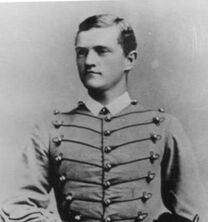 John Pershing as a West Point cadet (Photo: public domain) Pershing studied at Kirksville Normal School (now Truman State University), where he received his teaching degree in 1880. He taught African-American schoolchildren at Prairie Mound School, but became interested in law and went back to school to become a lawyer. When he decided that he could not get as good an education as he wanted in Missouri, he applied to the Military Academy at West Point, where cadets received a high-quality education for free in exchange for military service. At West Point, his leadership skills became apparent and he found himself in many command roles. He was the class president all four years. In 1885, when President Ulysses S. Grant’s funeral train passed West Point, Pershing commanded the honor guard. After graduating in 1886, Pershing was commissioned as a 2nd Lieutenant. He reported for duty in 6th U.S. Cavalry Regiment in New Mexico, where he participated in several Indian War campaigns, including fighting the Apaches led by Geronimo.
John Pershing as a West Point cadet (Photo: public domain) Pershing studied at Kirksville Normal School (now Truman State University), where he received his teaching degree in 1880. He taught African-American schoolchildren at Prairie Mound School, but became interested in law and went back to school to become a lawyer. When he decided that he could not get as good an education as he wanted in Missouri, he applied to the Military Academy at West Point, where cadets received a high-quality education for free in exchange for military service. At West Point, his leadership skills became apparent and he found himself in many command roles. He was the class president all four years. In 1885, when President Ulysses S. Grant’s funeral train passed West Point, Pershing commanded the honor guard. After graduating in 1886, Pershing was commissioned as a 2nd Lieutenant. He reported for duty in 6th U.S. Cavalry Regiment in New Mexico, where he participated in several Indian War campaigns, including fighting the Apaches led by Geronimo.Next, Pershing was posted to the University of Nebraska, where he taught military science. During his four years there, Pershing earned the law degree he’d so long wished for.
In 1896, he was promoted to 1st Lieutenant and assigned to a troop of the 10th Cavalry Regiment, one of the original regiments of Buffalo Soldiers, racially segregated black units. This began Pershing’s long association with black units.
Published on April 18, 2023 10:05
April 5, 2023
Horse Theft: not just in the Old West
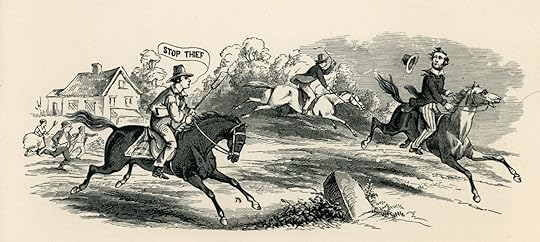 This drawing appears on all membership certificates of the Society in Dedham (Massachusetts) for Apprehending Horse Thieves. No one likes a horse thief. The term ‘horse thief’ is used not only for people who literally steal horses, but as an insult, implying that the person has no moral decency whatsoever. This may have come about because horses were central to life in the west during the 19th century. Without a horse, travel, farming, and ranching were virtually impossible. A person who stole a horse left his victim unable to support himself and unable to move on. In the Old West, the saying was that if you stole a man's horse, you had condemned him to death.
This drawing appears on all membership certificates of the Society in Dedham (Massachusetts) for Apprehending Horse Thieves. No one likes a horse thief. The term ‘horse thief’ is used not only for people who literally steal horses, but as an insult, implying that the person has no moral decency whatsoever. This may have come about because horses were central to life in the west during the 19th century. Without a horse, travel, farming, and ranching were virtually impossible. A person who stole a horse left his victim unable to support himself and unable to move on. In the Old West, the saying was that if you stole a man's horse, you had condemned him to death.Horse theft was such a problem that organizations were founded just to address the issue. The Anti Horse Thief Association, first organized in Missouri in 1854, grew to over 40,000 members spread across nine central and western US states. Between 1899 and 1909, they recovered $83,000 worth of livestock and saw the conviction of over 250 thieves in Oklahoma alone.
Because horse theft was such a serious crime, the punishments were also serious. In 1780, Pennsylvania passed "An Act to Increase the Punishments of Horse Stealing," which had a tiered system for dealing with offenders. First time offenders were given 39 lashes, then had their ears cut off and nailed to the pillory, where they had to stand for an hour. A second offense added branding of the forehead with an ‘H” and a ‘T.” This law was repealed in 1860. Horse theft was a hanging offense in many western states and territories. Often, the aggrieved would take justice into their own hands. These days, while punishments are not so severe, they can still be stiff. In 2011, one Arkansas woman was sentenced to 60 years in prison for stealing five horses and their equipment.
 While horses are no longer as important to life and well being as they once were, their theft is still relatively common. Horse Illustrated Magazine estimates that approximately 55,000 horses a year are taken from their lawful owners by strangers or opponents in civil or legal disputes. Organized groups of thieves often work one area or state, moving on when the law becomes aware of them. Other thieves move into areas that have suffered natural disasters such as wildfires and hurricanes, stealing animals that have escaped during the chaos and preying on vulnerable victims. Some stolen horses are killed for their meat. Others become the focus of ransom attempts. Many are resold with false papers at auction, or end up as riding mounts.
While horses are no longer as important to life and well being as they once were, their theft is still relatively common. Horse Illustrated Magazine estimates that approximately 55,000 horses a year are taken from their lawful owners by strangers or opponents in civil or legal disputes. Organized groups of thieves often work one area or state, moving on when the law becomes aware of them. Other thieves move into areas that have suffered natural disasters such as wildfires and hurricanes, stealing animals that have escaped during the chaos and preying on vulnerable victims. Some stolen horses are killed for their meat. Others become the focus of ransom attempts. Many are resold with false papers at auction, or end up as riding mounts.In my novel Summer of the Bombers, it is a wildfire that leads to the theft of a girl's horse. Punkin Davis has to ride her horse into the fictional town of Alamitos when a Forest Service Controlled burn jumps its lines because of high winds. In the parking lot of the high school that is organizing assistance for those affected by the fire, Punkin meets a woman who says she is from the Equine Assistance League, and will keep her horse in a safe place. Unfortunately, there is no Equine Assistance League, and woman and horse disappear. It takes Punkin quite a bit of time to get on her feet and figure out what she needs to do to get her horse back, but she finally gets the help she needs from Stolen Horse Internaational..
 While Summer of the Bombers might be a work of fiction, Stolen Horse International is not. The organization works diligently to recover stolen horses. Also known as NetPosse or SHI, it has been assisting horse owners with recovering their horses for over twenty-five years. It was founded by Debi and Harold Metcalfe after their own horse, Idaho, was stolen on September 26, 1997. Idaho was recovered after almost a year of searching. The non-profit organization relies on thousands of volunteers, who distribute fliers, usually by e-mail. In addition for helping in the search and recovery of horses, the organization works closely with law enforcement personnel to aid in the apprehension of the thieves.
While Summer of the Bombers might be a work of fiction, Stolen Horse International is not. The organization works diligently to recover stolen horses. Also known as NetPosse or SHI, it has been assisting horse owners with recovering their horses for over twenty-five years. It was founded by Debi and Harold Metcalfe after their own horse, Idaho, was stolen on September 26, 1997. Idaho was recovered after almost a year of searching. The non-profit organization relies on thousands of volunteers, who distribute fliers, usually by e-mail. In addition for helping in the search and recovery of horses, the organization works closely with law enforcement personnel to aid in the apprehension of the thieves.
 Debi Metcalfe's book, Horse Theft. Been There—Done That, explains how horse owners can protect their horses from theft, and what can be done to recover stolen horses. There are chapters on identification methods and prevention information that can stop theft from ever happening, and lots of resources to help if it does.
Debi Metcalfe's book, Horse Theft. Been There—Done That, explains how horse owners can protect their horses from theft, and what can be done to recover stolen horses. There are chapters on identification methods and prevention information that can stop theft from ever happening, and lots of resources to help if it does. This book was a fantastic resource for me as I wrote Summer of the Bombers. It's been a tremendous resource for many who've lost their horses. It is worth reading if you have a horse or know someone who does.
Now that my novel is complete, I would like to give my copy of this book away to someone who would benefit from it. Comment on this blog if you would like to be considered for it.
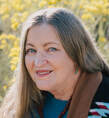 Jennifer Bohnhoff is a novelist who lives in the mountains of central New Mexico. An avid horsewoman in her youth, her novel Summer of the Bombers was inspired by the Cerro Grande Fire, which swept through Los Alamos during the summer of 2000.
Jennifer Bohnhoff is a novelist who lives in the mountains of central New Mexico. An avid horsewoman in her youth, her novel Summer of the Bombers was inspired by the Cerro Grande Fire, which swept through Los Alamos during the summer of 2000.
Published on April 05, 2023 09:02
March 29, 2023
Play Ball!
Baseball is America's sport! When it became America's sport well over a century ago, that really meant it was a sport for white males. Over time, like America itself, it's changed and become more inclusive. Now that opening day is here, it's time to share some great books about baseball with middle grade readers.  Like Madelyn l'Engle, Ellen Klages follows a family of brilliant and talented people through their adventurous life. L'Engle follows the Murry family through the series that begins with A Wrinkle in Time. Klages follows the Gordon family beginning with Green Glass Sea.
Like Madelyn l'Engle, Ellen Klages follows a family of brilliant and talented people through their adventurous life. L'Engle follows the Murry family through the series that begins with A Wrinkle in Time. Klages follows the Gordon family beginning with Green Glass Sea.
In Out of Left Field, youngest daughter, Katy Gordon is a baseball fanatic in a world where everything, except Little League admission rules, is changing. The San Francisco Seals, the hometown favorites for 50 years, are going away, to be replaced by the Giants. Sputnik is launched and schools in the south are being integrated. But Kay, who throws a mean pitch so singular that it doesn't even have a name, cannot join Little League because she's a girl. When her teacher assigns an American hero research paper, Katy delves deeply into the history of female baseball players in order to prove that the Little League rules make no sense.
This book has interesting, fully developed characters, and a plot line that shows how kids can change the world through activism, but it also paints a brilliant picture of what life was like in 1957. You can read this novel on its own, but it's even richer when read with its companion stories, Green Glass Sea and White Sands, Red Menace. If you're looking for a movie tie-in to Out of Left Field, try The Perfect Game. Based on a true story, this sweet and innocent movie tells the story of a group of boys from Monterrey, Mexico who became the first non-U.S. team to win the Little League World Series. It, too, is set in 1957 and gives a good picture of the prejudice against both blacks and hispanics that was common in that period.
If you're looking for a movie tie-in to Out of Left Field, try The Perfect Game. Based on a true story, this sweet and innocent movie tells the story of a group of boys from Monterrey, Mexico who became the first non-U.S. team to win the Little League World Series. It, too, is set in 1957 and gives a good picture of the prejudice against both blacks and hispanics that was common in that period.
 Get a Grip, Vivy Cohen is a sweet story about a girl with autism who wants to join a baseball team and pitch the knuckleball she learned from a pro player. Told in letters and emails between Vivy and VJ Capello, the major-league knuckleballer who's her hero (and a pretty nice guy for responding to all her letters!), this novel will help readers get into the head of a girl who's not much different despite her disabilities. She has to face bullies and her own personal fears when she gets on the mound, but she does it with bravery and honesty and a kindness towards others that is genuinely inspiring.
Get a Grip, Vivy Cohen is a sweet story about a girl with autism who wants to join a baseball team and pitch the knuckleball she learned from a pro player. Told in letters and emails between Vivy and VJ Capello, the major-league knuckleballer who's her hero (and a pretty nice guy for responding to all her letters!), this novel will help readers get into the head of a girl who's not much different despite her disabilities. She has to face bullies and her own personal fears when she gets on the mound, but she does it with bravery and honesty and a kindness towards others that is genuinely inspiring.
 Baseball Genius
was written by Tim Green and Derek Jeter, so you know the sports parts are dead-on accurate, exciting, and detailed enough to follow well: it's like listening to a game on the radio! The rest of the story is exciting, too: every one of the very short chapters has a cliff hanger of an ending that will keep even reluctant readers going. The story centers on Jalen DeLuca, the son of a hard-working immigrant father and a mother who's left the family to pursue her dream. Jalen's dad doesn't make enough at his Italian restaurant to support his son's baseball aspirations, so Jalen tries to make money by stealing balls from the home of the Yankee's second baseman. This starts a series of events that leads to Jalen using his uncanny ability to predict pitches to help the Yankee stay on the team. While most middle grade readers will love this book, I can't help but feel uncomfortable with the message that kids can steal and cheat if their circumstances justify it. Green and Jeter wrote this book before the Astros' infamous trashcan banging episode. I wonder how they feel about it now.
Baseball Genius
was written by Tim Green and Derek Jeter, so you know the sports parts are dead-on accurate, exciting, and detailed enough to follow well: it's like listening to a game on the radio! The rest of the story is exciting, too: every one of the very short chapters has a cliff hanger of an ending that will keep even reluctant readers going. The story centers on Jalen DeLuca, the son of a hard-working immigrant father and a mother who's left the family to pursue her dream. Jalen's dad doesn't make enough at his Italian restaurant to support his son's baseball aspirations, so Jalen tries to make money by stealing balls from the home of the Yankee's second baseman. This starts a series of events that leads to Jalen using his uncanny ability to predict pitches to help the Yankee stay on the team. While most middle grade readers will love this book, I can't help but feel uncomfortable with the message that kids can steal and cheat if their circumstances justify it. Green and Jeter wrote this book before the Astros' infamous trashcan banging episode. I wonder how they feel about it now.
 In The Grip, a Middle Grade book that reads like an autobiography, Marcus Stroman and co-author Samantha Thornhill team up on a story about a young ball player. Marcus showed talent from a young age, and his father is determined to make that talent pay off. Even though he and mom are divorced, he makes sure Marcus practices every morning. Eventually, Marcus feels overwhelmed by the mental pressure this brings, but his mother finds him a therapist who can help him deal with it.
In The Grip, a Middle Grade book that reads like an autobiography, Marcus Stroman and co-author Samantha Thornhill team up on a story about a young ball player. Marcus showed talent from a young age, and his father is determined to make that talent pay off. Even though he and mom are divorced, he makes sure Marcus practices every morning. Eventually, Marcus feels overwhelmed by the mental pressure this brings, but his mother finds him a therapist who can help him deal with it.
The book will help children explore what it is like to have parents divorce, being teased for being short, and the need to just be a kid. It is not a fast paced or exciting book, and the plot has no real surprises, but kids who have aspirations for the big league will find an affinity with Marcus and will appreciate knowing that even Golden Glove winners were kids once. Jenn Bishop's novel The Distance to Home tells the story of Quinnen, a girl who was the star pitcher on her baseball team, the Panthers. When her sister Haley dies, Quin loses heart for everything, including baseball. Told in chapters that alternate between last summer, when Haley died and this summer, when Quinn is still working through guilt and grief, the story slowly emerges as Quinn begins to understand that she isn't the only one affected by the death. As she develops empathy and understanding, she finds the courage to get back in the game. This book made me cry!
Jenn Bishop's novel The Distance to Home tells the story of Quinnen, a girl who was the star pitcher on her baseball team, the Panthers. When her sister Haley dies, Quin loses heart for everything, including baseball. Told in chapters that alternate between last summer, when Haley died and this summer, when Quinn is still working through guilt and grief, the story slowly emerges as Quinn begins to understand that she isn't the only one affected by the death. As she develops empathy and understanding, she finds the courage to get back in the game. This book made me cry!
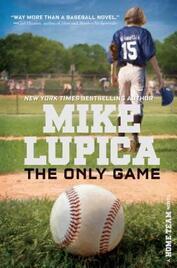 Another baseball book about a player dealing with the loss of a sibling is Mike Lupicia's The Only Game. Lupicia is the uncontested king of sports novels for middle grade readers; when I was still teaching, his books were in the hands of all my jock boys. He does a good job of describing the games like a true sports announcer, but he also does a good job of revealing the secret fears of middle school athletes. In this novel, the main character is a star pitcher, but feels so much guilt after his dare devil brother's accidental death that he leaves the team. What helps him heal is helping another kid named Teddy, whose weight and lack of confidence has kept him on the sidelines all his life.
Another baseball book about a player dealing with the loss of a sibling is Mike Lupicia's The Only Game. Lupicia is the uncontested king of sports novels for middle grade readers; when I was still teaching, his books were in the hands of all my jock boys. He does a good job of describing the games like a true sports announcer, but he also does a good job of revealing the secret fears of middle school athletes. In this novel, the main character is a star pitcher, but feels so much guilt after his dare devil brother's accidental death that he leaves the team. What helps him heal is helping another kid named Teddy, whose weight and lack of confidence has kept him on the sidelines all his life.
 I don't read a lot of graphic novels, but this one attracted me both because it was about baseball and because it was historical fiction. I'm glad I read it, and I think it's perfect for 3-7th grade boys, especially reluctant readers.
I don't read a lot of graphic novels, but this one attracted me both because it was about baseball and because it was historical fiction. I'm glad I read it, and I think it's perfect for 3-7th grade boys, especially reluctant readers.
The story in Stealing Home is about Sandy Saito, a Canadian of Japanese descent whose life changes when Japan attacks Pearl Harbor. Sandy is a typical boy. He reads comic books and loves baseball, especially the local Japanese team, the Asahi. Suddenly, he is perceived as different and dangerous. The Canadian government begins treating ethnic Japanese as enemy aliens, taking away their radios and cars. He is excluded from games and taunted by other children. Finally, his family is separated and forced to move to internment camps with substandard facilities.
J. Torres and David Nashimoto tell a fictional story with so much emotion and historic accuracy that it reads like a memoir. I especially appreciated the extensive background information and resources for further study that are in the back of the book . Linda Sue Park's Keeping Score is the story of Maggie Fortini, a Dodgers fan who lives in Brooklyn in the 1950s. Maggie can't play baseball for the same reason that Katy Gordon, the girl in Out in Left Field can't play: back then, it just wasn't allowed. Unlike Katy, Maggie doesn't buck the system. Instead, she learns to keep score from Jim, one of the guys down at the firestation where her father used to work. When Jim enlists and goes to Korea, keeping score is one of the things that connects her to Jim, and it develops into a child-like kind of magic that keeps the world orderly. But when the Dodgers lose AGAIN and then Jim stops writing, Maggie begins to question everything, even God.
Linda Sue Park's Keeping Score is the story of Maggie Fortini, a Dodgers fan who lives in Brooklyn in the 1950s. Maggie can't play baseball for the same reason that Katy Gordon, the girl in Out in Left Field can't play: back then, it just wasn't allowed. Unlike Katy, Maggie doesn't buck the system. Instead, she learns to keep score from Jim, one of the guys down at the firestation where her father used to work. When Jim enlists and goes to Korea, keeping score is one of the things that connects her to Jim, and it develops into a child-like kind of magic that keeps the world orderly. But when the Dodgers lose AGAIN and then Jim stops writing, Maggie begins to question everything, even God.
 The Sweet Spot
, Stacy Barnett Mozer, is a great book for athletic middle school and upper elementary girls. Thirteen-year-old Sam Barrette’s baseball coach tells her that her attitude's holding her back, but how can she not have an attitude when she has to listen to boys and people in the stands screaming things like “Go play softball,” all season, just because she's the only girl playing in the 13U league. Lovely and sensitive, this book will help guide girls through the difficulties of asserting themselves and becoming leaders in a man's world.
The Sweet Spot
, Stacy Barnett Mozer, is a great book for athletic middle school and upper elementary girls. Thirteen-year-old Sam Barrette’s baseball coach tells her that her attitude's holding her back, but how can she not have an attitude when she has to listen to boys and people in the stands screaming things like “Go play softball,” all season, just because she's the only girl playing in the 13U league. Lovely and sensitive, this book will help guide girls through the difficulties of asserting themselves and becoming leaders in a man's world.
 The Girl Who Threw Butterflies, by Mick Cochrane, is another book about a girl trying to play baseball. After her father's death in a car accident, eighth grader, Molly Williams decides to join the baseball team and show off the knuckleball her father taught her how to throw. Although the author does a little more telling than showing, this book also gives a fair picture of a girl overcoming hardships, both on the field and in her personal life.
The Girl Who Threw Butterflies, by Mick Cochrane, is another book about a girl trying to play baseball. After her father's death in a car accident, eighth grader, Molly Williams decides to join the baseball team and show off the knuckleball her father taught her how to throw. Although the author does a little more telling than showing, this book also gives a fair picture of a girl overcoming hardships, both on the field and in her personal life.
 Anne E. Burg's All the Broken Pieces is a novel in verse that tells the story of a twelve-year-old boy whose mother was Vietnamese and his father, an American soldier who abandoned him after the war. He flees his native Vietnam and is adopted in the U.S. is mother urged him to flee to the US, and now he lives with a caring adoptive family.
Anne E. Burg's All the Broken Pieces is a novel in verse that tells the story of a twelve-year-old boy whose mother was Vietnamese and his father, an American soldier who abandoned him after the war. He flees his native Vietnam and is adopted in the U.S. is mother urged him to flee to the US, and now he lives with a caring adoptive family.
It's a story about baseball, but it’s even more about fitting in, adoption, discrimination, post traumatic stress disorder, guilt and sorrow, and the difficulty of soldiers returning to the US after the war. Both haunting and lyrical, this book goes beyond the usual baseball-themed books to show an emotional picture of a specific and difficult time in history. Matt Pin is a boy between cultures, who can show the reader both sides of the story with grace and courage.
I've got one copy of this novel. Tell me in the comments that you'd like it and I'll pick one lucky responder to get it!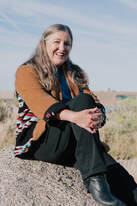 The links in this blog will take you to Bookshop.org, an online bookseller. I am an affiliate with Bookshop and receive a small commision when someone uses my link to purchase a book. A local bookstore also receives a commission. I appreciate the fact that this bookseller supports local businesses in a time when more and more sales go to distant, online retailers. Community is important and deserve our support.
The links in this blog will take you to Bookshop.org, an online bookseller. I am an affiliate with Bookshop and receive a small commision when someone uses my link to purchase a book. A local bookstore also receives a commission. I appreciate the fact that this bookseller supports local businesses in a time when more and more sales go to distant, online retailers. Community is important and deserve our support.
However, I encourage readers to check with their local libraries first!
Jennifer Bohnhoff is an author of books for readers from middle grade to adult. She is not an avid baseball fan, but she is married to one and loves to sit in the stands, eat a hot dog, and take in the action. You can read more about her and her books on her website.
 Like Madelyn l'Engle, Ellen Klages follows a family of brilliant and talented people through their adventurous life. L'Engle follows the Murry family through the series that begins with A Wrinkle in Time. Klages follows the Gordon family beginning with Green Glass Sea.
Like Madelyn l'Engle, Ellen Klages follows a family of brilliant and talented people through their adventurous life. L'Engle follows the Murry family through the series that begins with A Wrinkle in Time. Klages follows the Gordon family beginning with Green Glass Sea. In Out of Left Field, youngest daughter, Katy Gordon is a baseball fanatic in a world where everything, except Little League admission rules, is changing. The San Francisco Seals, the hometown favorites for 50 years, are going away, to be replaced by the Giants. Sputnik is launched and schools in the south are being integrated. But Kay, who throws a mean pitch so singular that it doesn't even have a name, cannot join Little League because she's a girl. When her teacher assigns an American hero research paper, Katy delves deeply into the history of female baseball players in order to prove that the Little League rules make no sense.
This book has interesting, fully developed characters, and a plot line that shows how kids can change the world through activism, but it also paints a brilliant picture of what life was like in 1957. You can read this novel on its own, but it's even richer when read with its companion stories, Green Glass Sea and White Sands, Red Menace.
 If you're looking for a movie tie-in to Out of Left Field, try The Perfect Game. Based on a true story, this sweet and innocent movie tells the story of a group of boys from Monterrey, Mexico who became the first non-U.S. team to win the Little League World Series. It, too, is set in 1957 and gives a good picture of the prejudice against both blacks and hispanics that was common in that period.
If you're looking for a movie tie-in to Out of Left Field, try The Perfect Game. Based on a true story, this sweet and innocent movie tells the story of a group of boys from Monterrey, Mexico who became the first non-U.S. team to win the Little League World Series. It, too, is set in 1957 and gives a good picture of the prejudice against both blacks and hispanics that was common in that period.
 Get a Grip, Vivy Cohen is a sweet story about a girl with autism who wants to join a baseball team and pitch the knuckleball she learned from a pro player. Told in letters and emails between Vivy and VJ Capello, the major-league knuckleballer who's her hero (and a pretty nice guy for responding to all her letters!), this novel will help readers get into the head of a girl who's not much different despite her disabilities. She has to face bullies and her own personal fears when she gets on the mound, but she does it with bravery and honesty and a kindness towards others that is genuinely inspiring.
Get a Grip, Vivy Cohen is a sweet story about a girl with autism who wants to join a baseball team and pitch the knuckleball she learned from a pro player. Told in letters and emails between Vivy and VJ Capello, the major-league knuckleballer who's her hero (and a pretty nice guy for responding to all her letters!), this novel will help readers get into the head of a girl who's not much different despite her disabilities. She has to face bullies and her own personal fears when she gets on the mound, but she does it with bravery and honesty and a kindness towards others that is genuinely inspiring.
 Baseball Genius
was written by Tim Green and Derek Jeter, so you know the sports parts are dead-on accurate, exciting, and detailed enough to follow well: it's like listening to a game on the radio! The rest of the story is exciting, too: every one of the very short chapters has a cliff hanger of an ending that will keep even reluctant readers going. The story centers on Jalen DeLuca, the son of a hard-working immigrant father and a mother who's left the family to pursue her dream. Jalen's dad doesn't make enough at his Italian restaurant to support his son's baseball aspirations, so Jalen tries to make money by stealing balls from the home of the Yankee's second baseman. This starts a series of events that leads to Jalen using his uncanny ability to predict pitches to help the Yankee stay on the team. While most middle grade readers will love this book, I can't help but feel uncomfortable with the message that kids can steal and cheat if their circumstances justify it. Green and Jeter wrote this book before the Astros' infamous trashcan banging episode. I wonder how they feel about it now.
Baseball Genius
was written by Tim Green and Derek Jeter, so you know the sports parts are dead-on accurate, exciting, and detailed enough to follow well: it's like listening to a game on the radio! The rest of the story is exciting, too: every one of the very short chapters has a cliff hanger of an ending that will keep even reluctant readers going. The story centers on Jalen DeLuca, the son of a hard-working immigrant father and a mother who's left the family to pursue her dream. Jalen's dad doesn't make enough at his Italian restaurant to support his son's baseball aspirations, so Jalen tries to make money by stealing balls from the home of the Yankee's second baseman. This starts a series of events that leads to Jalen using his uncanny ability to predict pitches to help the Yankee stay on the team. While most middle grade readers will love this book, I can't help but feel uncomfortable with the message that kids can steal and cheat if their circumstances justify it. Green and Jeter wrote this book before the Astros' infamous trashcan banging episode. I wonder how they feel about it now.
 In The Grip, a Middle Grade book that reads like an autobiography, Marcus Stroman and co-author Samantha Thornhill team up on a story about a young ball player. Marcus showed talent from a young age, and his father is determined to make that talent pay off. Even though he and mom are divorced, he makes sure Marcus practices every morning. Eventually, Marcus feels overwhelmed by the mental pressure this brings, but his mother finds him a therapist who can help him deal with it.
In The Grip, a Middle Grade book that reads like an autobiography, Marcus Stroman and co-author Samantha Thornhill team up on a story about a young ball player. Marcus showed talent from a young age, and his father is determined to make that talent pay off. Even though he and mom are divorced, he makes sure Marcus practices every morning. Eventually, Marcus feels overwhelmed by the mental pressure this brings, but his mother finds him a therapist who can help him deal with it.The book will help children explore what it is like to have parents divorce, being teased for being short, and the need to just be a kid. It is not a fast paced or exciting book, and the plot has no real surprises, but kids who have aspirations for the big league will find an affinity with Marcus and will appreciate knowing that even Golden Glove winners were kids once.
 Jenn Bishop's novel The Distance to Home tells the story of Quinnen, a girl who was the star pitcher on her baseball team, the Panthers. When her sister Haley dies, Quin loses heart for everything, including baseball. Told in chapters that alternate between last summer, when Haley died and this summer, when Quinn is still working through guilt and grief, the story slowly emerges as Quinn begins to understand that she isn't the only one affected by the death. As she develops empathy and understanding, she finds the courage to get back in the game. This book made me cry!
Jenn Bishop's novel The Distance to Home tells the story of Quinnen, a girl who was the star pitcher on her baseball team, the Panthers. When her sister Haley dies, Quin loses heart for everything, including baseball. Told in chapters that alternate between last summer, when Haley died and this summer, when Quinn is still working through guilt and grief, the story slowly emerges as Quinn begins to understand that she isn't the only one affected by the death. As she develops empathy and understanding, she finds the courage to get back in the game. This book made me cry!
 Another baseball book about a player dealing with the loss of a sibling is Mike Lupicia's The Only Game. Lupicia is the uncontested king of sports novels for middle grade readers; when I was still teaching, his books were in the hands of all my jock boys. He does a good job of describing the games like a true sports announcer, but he also does a good job of revealing the secret fears of middle school athletes. In this novel, the main character is a star pitcher, but feels so much guilt after his dare devil brother's accidental death that he leaves the team. What helps him heal is helping another kid named Teddy, whose weight and lack of confidence has kept him on the sidelines all his life.
Another baseball book about a player dealing with the loss of a sibling is Mike Lupicia's The Only Game. Lupicia is the uncontested king of sports novels for middle grade readers; when I was still teaching, his books were in the hands of all my jock boys. He does a good job of describing the games like a true sports announcer, but he also does a good job of revealing the secret fears of middle school athletes. In this novel, the main character is a star pitcher, but feels so much guilt after his dare devil brother's accidental death that he leaves the team. What helps him heal is helping another kid named Teddy, whose weight and lack of confidence has kept him on the sidelines all his life.
 I don't read a lot of graphic novels, but this one attracted me both because it was about baseball and because it was historical fiction. I'm glad I read it, and I think it's perfect for 3-7th grade boys, especially reluctant readers.
I don't read a lot of graphic novels, but this one attracted me both because it was about baseball and because it was historical fiction. I'm glad I read it, and I think it's perfect for 3-7th grade boys, especially reluctant readers. The story in Stealing Home is about Sandy Saito, a Canadian of Japanese descent whose life changes when Japan attacks Pearl Harbor. Sandy is a typical boy. He reads comic books and loves baseball, especially the local Japanese team, the Asahi. Suddenly, he is perceived as different and dangerous. The Canadian government begins treating ethnic Japanese as enemy aliens, taking away their radios and cars. He is excluded from games and taunted by other children. Finally, his family is separated and forced to move to internment camps with substandard facilities.
J. Torres and David Nashimoto tell a fictional story with so much emotion and historic accuracy that it reads like a memoir. I especially appreciated the extensive background information and resources for further study that are in the back of the book .
 Linda Sue Park's Keeping Score is the story of Maggie Fortini, a Dodgers fan who lives in Brooklyn in the 1950s. Maggie can't play baseball for the same reason that Katy Gordon, the girl in Out in Left Field can't play: back then, it just wasn't allowed. Unlike Katy, Maggie doesn't buck the system. Instead, she learns to keep score from Jim, one of the guys down at the firestation where her father used to work. When Jim enlists and goes to Korea, keeping score is one of the things that connects her to Jim, and it develops into a child-like kind of magic that keeps the world orderly. But when the Dodgers lose AGAIN and then Jim stops writing, Maggie begins to question everything, even God.
Linda Sue Park's Keeping Score is the story of Maggie Fortini, a Dodgers fan who lives in Brooklyn in the 1950s. Maggie can't play baseball for the same reason that Katy Gordon, the girl in Out in Left Field can't play: back then, it just wasn't allowed. Unlike Katy, Maggie doesn't buck the system. Instead, she learns to keep score from Jim, one of the guys down at the firestation where her father used to work. When Jim enlists and goes to Korea, keeping score is one of the things that connects her to Jim, and it develops into a child-like kind of magic that keeps the world orderly. But when the Dodgers lose AGAIN and then Jim stops writing, Maggie begins to question everything, even God.
 The Sweet Spot
, Stacy Barnett Mozer, is a great book for athletic middle school and upper elementary girls. Thirteen-year-old Sam Barrette’s baseball coach tells her that her attitude's holding her back, but how can she not have an attitude when she has to listen to boys and people in the stands screaming things like “Go play softball,” all season, just because she's the only girl playing in the 13U league. Lovely and sensitive, this book will help guide girls through the difficulties of asserting themselves and becoming leaders in a man's world.
The Sweet Spot
, Stacy Barnett Mozer, is a great book for athletic middle school and upper elementary girls. Thirteen-year-old Sam Barrette’s baseball coach tells her that her attitude's holding her back, but how can she not have an attitude when she has to listen to boys and people in the stands screaming things like “Go play softball,” all season, just because she's the only girl playing in the 13U league. Lovely and sensitive, this book will help guide girls through the difficulties of asserting themselves and becoming leaders in a man's world.
 The Girl Who Threw Butterflies, by Mick Cochrane, is another book about a girl trying to play baseball. After her father's death in a car accident, eighth grader, Molly Williams decides to join the baseball team and show off the knuckleball her father taught her how to throw. Although the author does a little more telling than showing, this book also gives a fair picture of a girl overcoming hardships, both on the field and in her personal life.
The Girl Who Threw Butterflies, by Mick Cochrane, is another book about a girl trying to play baseball. After her father's death in a car accident, eighth grader, Molly Williams decides to join the baseball team and show off the knuckleball her father taught her how to throw. Although the author does a little more telling than showing, this book also gives a fair picture of a girl overcoming hardships, both on the field and in her personal life.
 Anne E. Burg's All the Broken Pieces is a novel in verse that tells the story of a twelve-year-old boy whose mother was Vietnamese and his father, an American soldier who abandoned him after the war. He flees his native Vietnam and is adopted in the U.S. is mother urged him to flee to the US, and now he lives with a caring adoptive family.
Anne E. Burg's All the Broken Pieces is a novel in verse that tells the story of a twelve-year-old boy whose mother was Vietnamese and his father, an American soldier who abandoned him after the war. He flees his native Vietnam and is adopted in the U.S. is mother urged him to flee to the US, and now he lives with a caring adoptive family.It's a story about baseball, but it’s even more about fitting in, adoption, discrimination, post traumatic stress disorder, guilt and sorrow, and the difficulty of soldiers returning to the US after the war. Both haunting and lyrical, this book goes beyond the usual baseball-themed books to show an emotional picture of a specific and difficult time in history. Matt Pin is a boy between cultures, who can show the reader both sides of the story with grace and courage.
I've got one copy of this novel. Tell me in the comments that you'd like it and I'll pick one lucky responder to get it!
 The links in this blog will take you to Bookshop.org, an online bookseller. I am an affiliate with Bookshop and receive a small commision when someone uses my link to purchase a book. A local bookstore also receives a commission. I appreciate the fact that this bookseller supports local businesses in a time when more and more sales go to distant, online retailers. Community is important and deserve our support.
The links in this blog will take you to Bookshop.org, an online bookseller. I am an affiliate with Bookshop and receive a small commision when someone uses my link to purchase a book. A local bookstore also receives a commission. I appreciate the fact that this bookseller supports local businesses in a time when more and more sales go to distant, online retailers. Community is important and deserve our support.However, I encourage readers to check with their local libraries first!
Jennifer Bohnhoff is an author of books for readers from middle grade to adult. She is not an avid baseball fan, but she is married to one and loves to sit in the stands, eat a hot dog, and take in the action. You can read more about her and her books on her website.
Published on March 29, 2023 23:00
March 14, 2023
The Writing on the Wall
 Last month, my hiking group did the short but steep climb up to the Eye of the Sandias, a bit of graffiti in the southern Sandia Mountains, overlooking Tijeras Canyon and the village of Carnue.
Last month, my hiking group did the short but steep climb up to the Eye of the Sandias, a bit of graffiti in the southern Sandia Mountains, overlooking Tijeras Canyon and the village of Carnue. Where this painting came from is a mystery. In Sandia Mountain Hiking Guide, Mike Coltrin says “The Eye appeared sometime in the 1960s, but the originator is unknown.”
One blogger calls the painting an adaptation of an ancient Egyptian symbol of protection, power and health, the Eye of Horus. The artist, or some later artist, made the eye New Mexican by substituting a Zia Sun symbol for the pupil. Several sources suggest that the teardrops show the mountain's grief over the encroachment of suburbia or the roar of I-40 through the canyon below it.
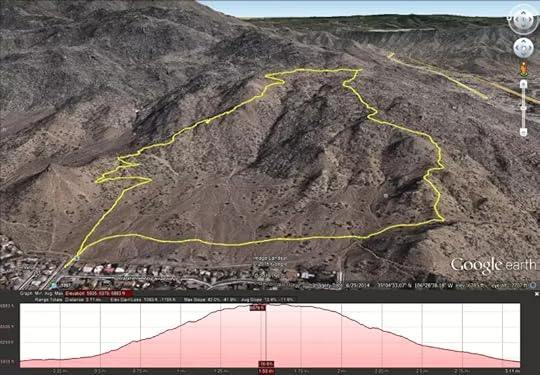 source: https://pngyoung.com/Hiking/eye-of-th... The hike is not an easy one. It gains almost a thousand feet in a distance just over three miles. Some of the trails have slopes approaching 45% and are covered with granite gravel that rolls underfoot. But the views are worth it.
source: https://pngyoung.com/Hiking/eye-of-th... The hike is not an easy one. It gains almost a thousand feet in a distance just over three miles. Some of the trails have slopes approaching 45% and are covered with granite gravel that rolls underfoot. But the views are worth it.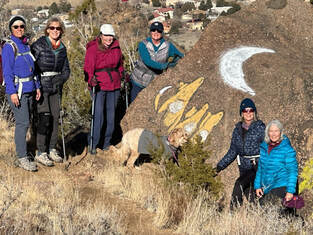 Our group parked at the trailhead parking lot at the top of Copper. We walked the loop trail going clockwise to avoid going down the steepest parts.
Our group parked at the trailhead parking lot at the top of Copper. We walked the loop trail going clockwise to avoid going down the steepest parts.On our way up, we also encountered this rock art, which depicts three coyotes howling at the moon. It is decidedly modern, but the coyote pictured below, which is from the La Cieneguilla Petroglyph Site, west of Santa Fe isn't.
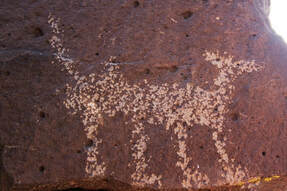 https://naturetime.wordpress.com/2012... New Mexico has thousands of petroglyphs and pictographs. Some were created by ancient cultures: the Ancestral Puebloan and Mogollon Indians. Later, Apaches and Navajos added their contributions. Early Spanish explorers, and then Anglo frontiersmen, bored cowboys left their marks and initials on rocks. As the Eye of the Sandia proves, the art of embellishing rocks continues. New Mexico's rock art stretches back into prehistoric times, but is still new compared to rock art in other parts of the world. The island of Sulawesi, in Indonesia has some rock art that is at least 45,500 years old. .The cave paintings at Chauvet Cave in modern day France were created sometime between 43,000 and 65,000 years ago. That's 20,000 years before the first modern humans arrived in Europe. The oldest known cave paintings, those from La Pasiega, Maltravieso and Ardales, in modern day Spain, were created at least 64,000 years ago, and most likely by Neanderthals. It appears that the desire to decorate rock is older than modern man.
https://naturetime.wordpress.com/2012... New Mexico has thousands of petroglyphs and pictographs. Some were created by ancient cultures: the Ancestral Puebloan and Mogollon Indians. Later, Apaches and Navajos added their contributions. Early Spanish explorers, and then Anglo frontiersmen, bored cowboys left their marks and initials on rocks. As the Eye of the Sandia proves, the art of embellishing rocks continues. New Mexico's rock art stretches back into prehistoric times, but is still new compared to rock art in other parts of the world. The island of Sulawesi, in Indonesia has some rock art that is at least 45,500 years old. .The cave paintings at Chauvet Cave in modern day France were created sometime between 43,000 and 65,000 years ago. That's 20,000 years before the first modern humans arrived in Europe. The oldest known cave paintings, those from La Pasiega, Maltravieso and Ardales, in modern day Spain, were created at least 64,000 years ago, and most likely by Neanderthals. It appears that the desire to decorate rock is older than modern man.
 My dual timeline novel The Last Song of the Swan retells the story of Beowulf, an Old English epic about a hero who destroys a monster that is raiding a Danish mead-hall. One of the timelines in the novel is modern: a present day high school girl who must write a paper on Beowulf and wonders about the characters. The other timeline is set deep into prehistory, at a time when Neanderthals and modern men co-inhabited those parts of Europe that weren't covered in sheets of ice. My son, the artist Matt Bohnhoff, created modern cave art interpretations to introduce each chapter, and to embellish the cover: rock art that never appeared on rock, but on paper.
My dual timeline novel The Last Song of the Swan retells the story of Beowulf, an Old English epic about a hero who destroys a monster that is raiding a Danish mead-hall. One of the timelines in the novel is modern: a present day high school girl who must write a paper on Beowulf and wonders about the characters. The other timeline is set deep into prehistory, at a time when Neanderthals and modern men co-inhabited those parts of Europe that weren't covered in sheets of ice. My son, the artist Matt Bohnhoff, created modern cave art interpretations to introduce each chapter, and to embellish the cover: rock art that never appeared on rock, but on paper.
 Jennifer Bohnhoff writes historical and contemporary fiction for middle grade through adult readers. She lives in the mountains of central New Mexico, but hikes wherever trails, rock art, and beauty can be found.
Jennifer Bohnhoff writes historical and contemporary fiction for middle grade through adult readers. She lives in the mountains of central New Mexico, but hikes wherever trails, rock art, and beauty can be found.
Published on March 14, 2023 08:38
March 8, 2023
Why do Cowboys Wear Huge Belt Buckles?
In Summer of the Bombers, my novel scheduled to be published April 10, the main character's house burns down when a controlled burn turns into a wild fire. One of the things that "Punkin" Davis misses the most is her rodeo belt buckle.  When I taught in a middle school that was part of a ranching community, many of my students wore big, shiny belt buckles that they were very proud of. Western belt buckles are not just fashion; they have an interesting history and serve an important purpose in Western culture.
When I taught in a middle school that was part of a ranching community, many of my students wore big, shiny belt buckles that they were very proud of. Western belt buckles are not just fashion; they have an interesting history and serve an important purpose in Western culture.

Until the late 1800s, most men, including cowboys, didn’t wear belts with buckles at all. Pants were high-waisted, and tightened with a cinch at the back, or were held up with suspenders. It wasn’t until after Levi Strauss began mass-producing dungaree jeans that had belt loops that men, including cowboys, gave up suspenders and began wearing belts with buckles. Most buckles then, as now, had a square or rectangular piece of metal attached to one end of the belt, with a tongue that went through a hole in the leather to secure it.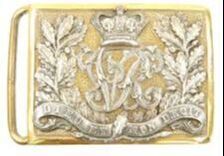 Victorian British Army Officer's buckle The big buckles that cowboys wear have their origins in the buckles worn by soldiers in European Armies, who expected their soldiers to look sharp when they headed into battle. Each unit issued a different belt buckle to their men, making them easy to distinguish from one another. These buckles were often made of brass and engraved with heraldry or insignia that identified their leader. The buckles of officers were more elaborate, and sometimes made of gold. It became a tradition for these buckles to be worn at parades and other important events long after the war in which it was issued was over.
Victorian British Army Officer's buckle The big buckles that cowboys wear have their origins in the buckles worn by soldiers in European Armies, who expected their soldiers to look sharp when they headed into battle. Each unit issued a different belt buckle to their men, making them easy to distinguish from one another. These buckles were often made of brass and engraved with heraldry or insignia that identified their leader. The buckles of officers were more elaborate, and sometimes made of gold. It became a tradition for these buckles to be worn at parades and other important events long after the war in which it was issued was over.
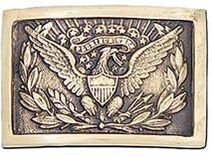 US Army Officer's buckle, 1855 United States picked up the practice of military belt buckles by the time of the Civil War. From 1861 to 1865, friction belt buckles were mass produced in large quantities. These buckles where the belt is pulled behind and through the buckle to keep the belt in place were issued. Those buckles don’t have a prong or hole, and were made of brass. After the end of the Civil War, many veterans kept their buckles.
US Army Officer's buckle, 1855 United States picked up the practice of military belt buckles by the time of the Civil War. From 1861 to 1865, friction belt buckles were mass produced in large quantities. These buckles where the belt is pulled behind and through the buckle to keep the belt in place were issued. Those buckles don’t have a prong or hole, and were made of brass. After the end of the Civil War, many veterans kept their buckles.
Most American military units have switched back to functional buckles. The exception is the U.S. Army Cavalry, which stuck with European tradition and maintains large and ornate buckles that incorporated heraldry elements.
 When competitive and organized rodeos started in late 19th century Colorado, the only cowboys who wore buckles were veterans of the American Civil War. Then, in the 1920s, men’s pants fashion changed. With the lower waistline, belts became a more practical way to keep them up. About the same time, Hollywood began glamorizing the wild west. Hollywood cowboys such as Tom Mix and Gene Autry wore flashy buckles that audiences all across America oohed and ahhed over. In 1920, the San Francisco Cow Palace in California began awarding buckles as prizes at professional rodeo events.
When competitive and organized rodeos started in late 19th century Colorado, the only cowboys who wore buckles were veterans of the American Civil War. Then, in the 1920s, men’s pants fashion changed. With the lower waistline, belts became a more practical way to keep them up. About the same time, Hollywood began glamorizing the wild west. Hollywood cowboys such as Tom Mix and Gene Autry wore flashy buckles that audiences all across America oohed and ahhed over. In 1920, the San Francisco Cow Palace in California began awarding buckles as prizes at professional rodeo events.
Because belt buckles continue to be awarded for accomplishments such as barrel racing, bull riding, team roping, tie down roping and more, trophy buckles are sort of a cowboy’s resume. The most coveted buckles are those awarded by the PRCA, and once earned, are worn with pride. Of course, not all big belt buckles are awards. Large belt buckles are also for sale. Some have the name of a dude ranch on them and can be bought by tourists. Other buckles feature places of interest, animals, or even brands of trucks. But the ones worn with the most pride have been earned. Summer of the Bombers, a middle grade contemporary novel about the devastating effects of a wildfire, is scheduled to be published on April 10th. You can preorder the ebook version on Amazon, or the paperback through the author.
Summer of the Bombers, a middle grade contemporary novel about the devastating effects of a wildfire, is scheduled to be published on April 10th. You can preorder the ebook version on Amazon, or the paperback through the author.
When a controlled burn goes out of control, it burns a path a destruction through everything that fourteen-year-old Margaret “Punkin” Davis loves. Her home is destroyed, her horse is stolen, and her family is broken apart. She must find the inner strength to rebuild her life one piece at a time or lose everything.
This YA novel about resilience and self determination is based on the events of the devastating Cerro Grande Fire in May, 2000, one of many wild fires that have raged throughout the Western United States.
 When I taught in a middle school that was part of a ranching community, many of my students wore big, shiny belt buckles that they were very proud of. Western belt buckles are not just fashion; they have an interesting history and serve an important purpose in Western culture.
When I taught in a middle school that was part of a ranching community, many of my students wore big, shiny belt buckles that they were very proud of. Western belt buckles are not just fashion; they have an interesting history and serve an important purpose in Western culture.

Until the late 1800s, most men, including cowboys, didn’t wear belts with buckles at all. Pants were high-waisted, and tightened with a cinch at the back, or were held up with suspenders. It wasn’t until after Levi Strauss began mass-producing dungaree jeans that had belt loops that men, including cowboys, gave up suspenders and began wearing belts with buckles. Most buckles then, as now, had a square or rectangular piece of metal attached to one end of the belt, with a tongue that went through a hole in the leather to secure it.
 Victorian British Army Officer's buckle The big buckles that cowboys wear have their origins in the buckles worn by soldiers in European Armies, who expected their soldiers to look sharp when they headed into battle. Each unit issued a different belt buckle to their men, making them easy to distinguish from one another. These buckles were often made of brass and engraved with heraldry or insignia that identified their leader. The buckles of officers were more elaborate, and sometimes made of gold. It became a tradition for these buckles to be worn at parades and other important events long after the war in which it was issued was over.
Victorian British Army Officer's buckle The big buckles that cowboys wear have their origins in the buckles worn by soldiers in European Armies, who expected their soldiers to look sharp when they headed into battle. Each unit issued a different belt buckle to their men, making them easy to distinguish from one another. These buckles were often made of brass and engraved with heraldry or insignia that identified their leader. The buckles of officers were more elaborate, and sometimes made of gold. It became a tradition for these buckles to be worn at parades and other important events long after the war in which it was issued was over.
 US Army Officer's buckle, 1855 United States picked up the practice of military belt buckles by the time of the Civil War. From 1861 to 1865, friction belt buckles were mass produced in large quantities. These buckles where the belt is pulled behind and through the buckle to keep the belt in place were issued. Those buckles don’t have a prong or hole, and were made of brass. After the end of the Civil War, many veterans kept their buckles.
US Army Officer's buckle, 1855 United States picked up the practice of military belt buckles by the time of the Civil War. From 1861 to 1865, friction belt buckles were mass produced in large quantities. These buckles where the belt is pulled behind and through the buckle to keep the belt in place were issued. Those buckles don’t have a prong or hole, and were made of brass. After the end of the Civil War, many veterans kept their buckles. Most American military units have switched back to functional buckles. The exception is the U.S. Army Cavalry, which stuck with European tradition and maintains large and ornate buckles that incorporated heraldry elements.
 When competitive and organized rodeos started in late 19th century Colorado, the only cowboys who wore buckles were veterans of the American Civil War. Then, in the 1920s, men’s pants fashion changed. With the lower waistline, belts became a more practical way to keep them up. About the same time, Hollywood began glamorizing the wild west. Hollywood cowboys such as Tom Mix and Gene Autry wore flashy buckles that audiences all across America oohed and ahhed over. In 1920, the San Francisco Cow Palace in California began awarding buckles as prizes at professional rodeo events.
When competitive and organized rodeos started in late 19th century Colorado, the only cowboys who wore buckles were veterans of the American Civil War. Then, in the 1920s, men’s pants fashion changed. With the lower waistline, belts became a more practical way to keep them up. About the same time, Hollywood began glamorizing the wild west. Hollywood cowboys such as Tom Mix and Gene Autry wore flashy buckles that audiences all across America oohed and ahhed over. In 1920, the San Francisco Cow Palace in California began awarding buckles as prizes at professional rodeo events.
Because belt buckles continue to be awarded for accomplishments such as barrel racing, bull riding, team roping, tie down roping and more, trophy buckles are sort of a cowboy’s resume. The most coveted buckles are those awarded by the PRCA, and once earned, are worn with pride. Of course, not all big belt buckles are awards. Large belt buckles are also for sale. Some have the name of a dude ranch on them and can be bought by tourists. Other buckles feature places of interest, animals, or even brands of trucks. But the ones worn with the most pride have been earned.
 Summer of the Bombers, a middle grade contemporary novel about the devastating effects of a wildfire, is scheduled to be published on April 10th. You can preorder the ebook version on Amazon, or the paperback through the author.
Summer of the Bombers, a middle grade contemporary novel about the devastating effects of a wildfire, is scheduled to be published on April 10th. You can preorder the ebook version on Amazon, or the paperback through the author. When a controlled burn goes out of control, it burns a path a destruction through everything that fourteen-year-old Margaret “Punkin” Davis loves. Her home is destroyed, her horse is stolen, and her family is broken apart. She must find the inner strength to rebuild her life one piece at a time or lose everything.
This YA novel about resilience and self determination is based on the events of the devastating Cerro Grande Fire in May, 2000, one of many wild fires that have raged throughout the Western United States.
Published on March 08, 2023 23:00
March 1, 2023
A Short History of Wildfire Management
 Wildfires have been a natural part of the ecosystem since the beginning of time. Fossilized charcoal shows that the first wildfires occurred approximately 419 million years ago, soon after the first terrestrial plants evolved. The fact that areas that have frequent wildfires have higher species richness and diversity than unburned old forest areas indicates that fires benefit ecosystems. However, what is good for the forest is not always good for man. Man’s intervention has led to changes in the fires themselves. New Mexico, like much of the American West, possesses characteristics that make wildfires common. In prehistoric times, the area’s volcanism might have contributed to burns. Now, the most common non-human cause of fires is lightning. Climatic cycles also contribute to the likelihood of wildfires. The heavy rains and deep snows of wet periods create crowded stands of small trees and thick underbrush. These become fuel during periods of drought. This fuel allows the naturally occurring ground fires to become the high-intensity crown fires.
Wildfires have been a natural part of the ecosystem since the beginning of time. Fossilized charcoal shows that the first wildfires occurred approximately 419 million years ago, soon after the first terrestrial plants evolved. The fact that areas that have frequent wildfires have higher species richness and diversity than unburned old forest areas indicates that fires benefit ecosystems. However, what is good for the forest is not always good for man. Man’s intervention has led to changes in the fires themselves. New Mexico, like much of the American West, possesses characteristics that make wildfires common. In prehistoric times, the area’s volcanism might have contributed to burns. Now, the most common non-human cause of fires is lightning. Climatic cycles also contribute to the likelihood of wildfires. The heavy rains and deep snows of wet periods create crowded stands of small trees and thick underbrush. These become fuel during periods of drought. This fuel allows the naturally occurring ground fires to become the high-intensity crown fires.  In 1872, Yellowstone, the world's first national park, was established. Fifteen years later, the U. S. Army was assigned the responsibility for its protection.
In 1872, Yellowstone, the world's first national park, was established. Fifteen years later, the U. S. Army was assigned the responsibility for its protection. The Army did not have enough soldiers to fight all of the naturally occurring fires and concentrated on those that were close to roads or human habitation. However, several deadly fires, most notably the 1871 Peshtigo Fire, which killed more than 1,500 people, the 1889 Santiago Canyon Fire, and the 1910 Great Fire made the public believe that all fires were bad. In 1916, the National Park Service took over park management from the Army and fire suppression became the only fire policy for the next fifty years.
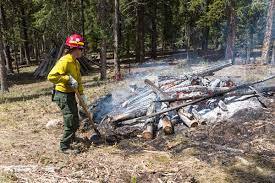 In the 1960s, the government changed its policy. It once again recognized fire as a necessary ecological process. Fires were to be allowed to run their courses as long as they could be contained within fire management units and accomplished approved management objectives. Controlled burns were established to reduce the low-level fuels, keeping fires from becoming crown fires. However, fires, both natural and man made, do not always follow government rules.
In the 1960s, the government changed its policy. It once again recognized fire as a necessary ecological process. Fires were to be allowed to run their courses as long as they could be contained within fire management units and accomplished approved management objectives. Controlled burns were established to reduce the low-level fuels, keeping fires from becoming crown fires. However, fires, both natural and man made, do not always follow government rules.  Jennifer Bohnhoff's next book, Summer of the Bombers, tells the story of a girl who loses everything as a result of a controlled burn that jumps the barriers and races through her town. Scheduled to be published on April 10, it is available to preorder in digital form on Amazon or in paperback directly through the author.
Jennifer Bohnhoff's next book, Summer of the Bombers, tells the story of a girl who loses everything as a result of a controlled burn that jumps the barriers and races through her town. Scheduled to be published on April 10, it is available to preorder in digital form on Amazon or in paperback directly through the author.
Published on March 01, 2023 23:00
February 26, 2023
A New Cover for a New Book

Back in the spring of 2000, a controlled burn in the Jemez Mountains jumped its control lines and became a raging wildfire. Known at the Cerro Grande fire, it burned over 400 homes in Los Alamos, New Mexico, shut down the National Laboratory there, and threw life into confusion and chaos for thousands of residents.
The news story stuck with me for a long time, haunting my thoughts and leading me to ask a lot of questions. What would it have been like to live through something like that? How would losing one's home affect a family? What about the pets of the people burned out? Was everyone helpful, or did predators also descend on the victims of this fire?
Finally, my thoughts propelled me to write. I began writing Summer of the Bombers in 2014, during November's National Novel Writing challenge. I got a third of the way through, then set it aside. I didn't pick it up again for eight years.

I usually create a mock-up cover early in the writing process. It helps me think about what I have to say and where the story is going. When I pulled out the manuscript began working on it again last year, I created a cover that had some of the elements of the story in it. Fire. Forest. One of the bombers that dropped fire retardant on the flames, and whose drone became the background music for the entire time that the fire raged. I also included a picture of someone on horseback because that horse and his rider are central to the story.
Does anyone recognize the horse and rider? I took that image from another of my novels!
But while creating a cover to help guide my writing is helpful, what I create isn't professional enough for the published novel itself. A published novel needs a cover that reflects the story and lets the reader know what genre the book is in. Horror covers look very different from Romance covers, and a cover for a middle grade novel must be different from a novel written for adults. Many of my latest covers have been created by a Ukrainian company called Get Covers. I gave the artist a brief synopsis of the story, similar to this copy, which I plan to put on the back cover: When the Forest Service announces a controlled burn to clear dead wood from the National Forest, no one in Alamitos, New Mexico is worried. But the fire goes out of control, burning a path of destruction that threatens everything that fourteen-year-old Margaret “Punkin” Davis holds dear. Her home destroyed, her horse stolen and her family broken apart, she must find the inner strength to rebuild her life one piece at a time or lose everything.
Based on events during the devastating Cerro Grande Fire in May, 2000, one of many wild fires that have raged throughout the Western United States, this is a novel about resilience and self determination.
I also told the artist that Punkin was a redhead and Wildfire, her horse, was a Palomino. The novel is a YA, short for young adult novel, which means that anyone from the sixth or seventh grade on up would be able to read it. Based on that, this is what the artist came up with:

 I showed this cover to my critique group, and they were less than enthusiastic. While the girl is a redhead, the look on her face made them feel that this was a horror novel, and the background was just too grim for them. They wondered if people looking at it might think she'd caused the fire. Was she a firebomber? An arsonist?
I showed this cover to my critique group, and they were less than enthusiastic. While the girl is a redhead, the look on her face made them feel that this was a horror novel, and the background was just too grim for them. They wondered if people looking at it might think she'd caused the fire. Was she a firebomber? An arsonist?This was closer, but not quite right, either. My critique group thought it looked like the girl's hair was on fire! They also thought the bomber looked pretty toy-like: definitely not the type of plane we'd seen leaving Kirtland Airforce Base with a belly full of slurry. Also, this girl is way fancier than my Punkin. She'd never wear a top like that one! And the horse was not the Palomino I'd written about. I went back to the artist again.
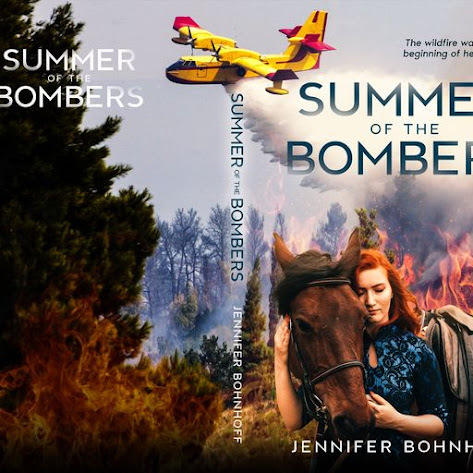
They say the third time's a charm. The artist was able to find a better plane, and make the slurry the orangy-red color that most of us had seen on news clips. She was also able to change Punkin's shirt into something a little more suitable for the character. But she wasn't able to change the horse, or get rid of the model's fingernail polish.
So the mountain came to Mohammed. I contacted my rancher friend (whose help with the horsey and cow scenes in my books has been invaluable!) who could tell me that the horse in the picture was a bay. I changed the story to make my horse a bay, and I added a scene where another character talked Punkin into trying nail polish. It's funny, the things we have to do as writers!
Here is the final cover (minus the back copy.) What do you think?
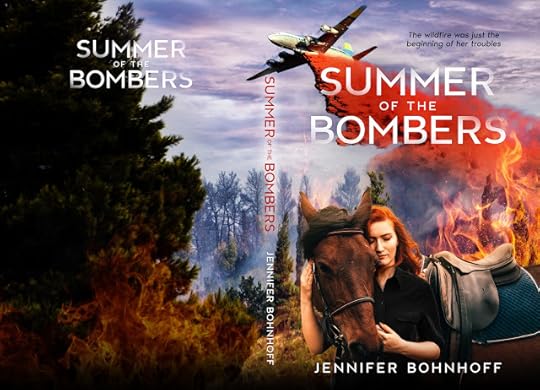
Published on February 26, 2023 06:02



